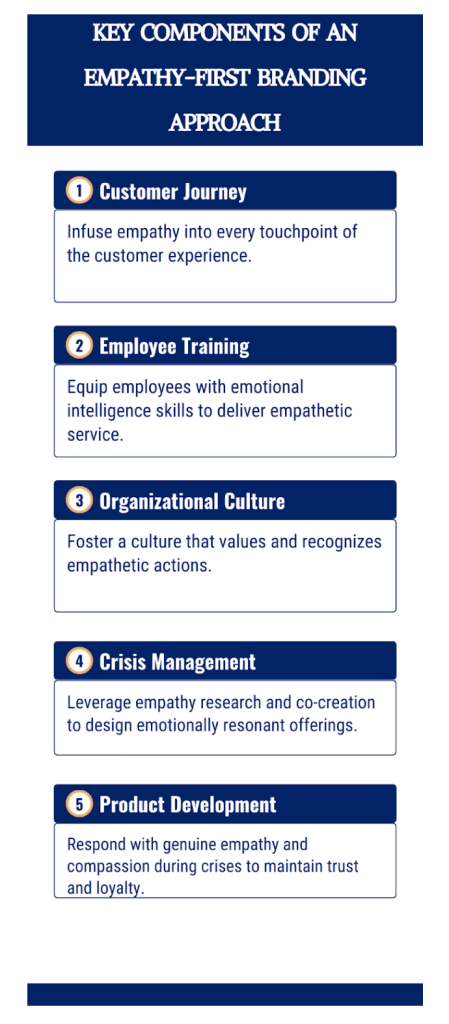
In today’s crowded marketplace, it’s no longer enough for brands to simply offer great products or services. To stand out and cultivate lasting loyalty, companies must forge deep emotional connections with their customers.
This is where the power of global empathy comes into play – by deeply understanding and responding to the emotions that drive consumer behavior, brands can create unbreakable bonds that keep customers coming back time and time again.
The Emotional Quotient of Brands
Brands that leverage emotional intelligence and empathy consistently outperform their competitors in key metrics like customer satisfaction and brand loyalty. According to Forbes, companies that prioritize emotional connections outperform those that don’t by 85% in sales growth.
This trend underscores the profound impact emotional branding can have on a company’s bottom line. Savvy brands can forge lasting connections that transcend transactional relationships by tapping into the psychological drivers that shape consumer emotions.
The Science Behind Emotion-Driven Loyalty
Psychological Foundations
At its core, emotional branding is rooted in the psychological principles that govern how we form attachments and associations. Research has shown that brand attitudes – the positive or negative emotional states consumers develop towards a brand – are shaped by the specific experiences and attributes associated with that brand.
For instance, a study examining consumer empathy towards low-cost airlines found that evoking feelings of compassion during the service experience can help foster positive brand attitudes like trust and liking. This emotional connection, in turn, drives repeat business and loyalty.
Neurological Response to Branding
But emotional branding isn’t just about psychology – it also taps into the fundamental neurological responses that shape our decision-making processes. Certain branding strategies have been shown to trigger activity in the reward centers of the brain, creating a sense of pleasure and positive reinforcement that can lead to lasting brand loyalty.
By understanding these neurological pathways by doing empathy research brands can craft marketing and customer experiences that elicit the desired emotional responses, solidifying their position in the minds and hearts of consumers.
Strategies for Cultivating Brand Empathy
Listening with Intent
The foundation of any successful emotional branding strategy is a deep understanding of your target audience’s emotional needs, desires, and pain points. This requires active listening and a willingness to engage with customers on a deeper level.
Social media and customer feedback channels offer rich sources of insight into the emotional states and motivations of your audience. By monitoring these channels and responding with customer empathy and authenticity, brands can demonstrate a genuine commitment to understanding and addressing their customers’ emotions.
Content That Resonates
Armed with this emotional intelligence, brands can then create content that truly resonates with their audience on an emotional level. This could take the form of storytelling that evokes specific emotional responses, educational content that addresses common pain points, or messaging that aligns with the aspirations and values of your target consumers.
By crafting content that speaks directly to the emotional drivers of their audience, brands can forge deeper connections and cultivate a sense of emotional investment in their products or services.
Community Building as an Empathy Exercise
One of the most powerful ways to foster emotional connections is through the creation of brand communities. Brands can deepen customer loyalty by bringing together like-minded individuals who share common interests, values, and emotional motivations, fostering a sense of belonging and exclusivity.
Harley-Davidson, for example, has cultivated a passionate community of riders united by a shared love of freedom, adventure, and the open road. This sense of community and shared experience has helped cement the brand’s emotional resonance and inspire unwavering loyalty among its customer base.
Implementing an Empathy-First Approach
Creating an empathetic brand involves translating insights into actionable strategies that permeate every aspect of the business, beyond just understanding consumer emotions. Implementing an empathy-first approach requires a holistic, organization-wide commitment to infusing empathy into all touchpoints of the customer journey, from product development to employee training, organizational culture, and crisis management.

By adopting a comprehensive, empathy-driven mindset, brands can create immersive and emotionally resonant experiences that reinforce their core values and forge deeper connections with their audience.
From Insight to Action
Translating emotional insights into actionable branding strategies is a delicate balancing act. It requires a holistic approach that encompasses everything from product design and marketing campaigns to customer service interactions and crisis management.
By infusing empathy into every touchpoint of the customer journey, brands can create a consistent and immersive emotional experience that reinforces their core values and resonates with their audience on a deeper level.
Empathy in Crisis Management
Perhaps one of the most critical applications of empathy insights in branding is crisis management. In the face of public relations challenges or consumer backlash, a brand’s ability to respond with genuine empathy and compassion can make or break its reputation and customer trust.
Brands that prioritize empathy in their crisis communications and demonstrate a willingness to listen, understand, and address the emotional concerns of their customers are far more likely to weather the storm and emerge with their brand loyalty intact.
Employee Training and Culture
Building an empathetic brand starts from within. Companies must prioritize empathy research and training for employees, ensuring that they have the emotional intelligence skills to deliver exceptional customer experiences. This includes active listening, emotional awareness, and the ability to understand and respond to the emotional needs of customers.
Moreover, organizations must cultivate a culture of customer empathy, where employees feel empowered to prioritize emotional connections and are recognized for their empathetic actions.
Consumer Empathy in Product Development
Empathy should also be a guiding principle in product development. By deeply understanding the emotional needs, frustrations, and aspirations of their target customers, brands can design products and services that resonate on a deeper level.
This could involve leveraging empathy studies, user testing, and co-creation methods that involve customers in the development process, ensuring that the final offering addresses their emotional drivers.
Measuring the Impact of Global Empathy on Brand Loyalty
Key Performance Indicators (KPIs) for Emotional Branding
To effectively measure the impact of emotional branding efforts, companies must identify and track relevant Key Performance Indicators (KPIs). Some common metrics to consider include:
- Repeat Purchase Rate: A high rate of repeat purchases is a strong indicator of brand loyalty and emotional attachment.
- Net Promoter Score (NPS): This metric measures the likelihood of customers recommending your brand to others, reflecting their overall emotional sentiment.
- Social Media Engagement: Active engagement, shares, and positive sentiment on social media channels can signify strong emotional connections.
- Customer Lifetime Value (CLV): Tracking emotionally loyal customers’ lifetime value is crucial, as they tend to have a higher value.
By monitoring these and other relevant KPIs, brands can quantify the impact of their emotional branding strategies and make data-driven adjustments to optimize their efforts.
Frequently Asked Questions
- How can small businesses with limited budgets implement effective emotional branding strategies?
While large corporations may have more resources to dedicate to emotional branding initiatives, small businesses can still leverage the power of empathy through targeted, cost-effective strategies. This could involve creating a sense of community, personalized experiences, and authentic storytelling
- In the age of data privacy concerns, how can brands ethically gather insights into consumer emotions?
Respecting consumer privacy is paramount when gathering emotional insights. Brands should prioritize transparency and seek explicit consent from customers before collecting and utilizing their data. Incentivized engagement through educational videos, profile surveys, polls, and social media interactions can be effective ways to gather deeper customer insights while addressing privacy concerns.
- What are the common pitfalls in attempting to form emotional connections with consumers, and how can they be avoided?
Some common pitfalls in emotional branding include failing to listen to customer feedback, inauthentic messaging, and inconsistency in messaging or experiences can undermine brand empathy.






